
King penguins (Aptenodytes patagonicus) molting, Grytviken,
South Georgia.
Part 2. Penguins
To many people, penguins are a symbol of the Antarctic, and,
indeed, they are the most joyful part of any trip to the shores and seas of the
Far South. Although some of them occur all the way to the Equator, and the highest
species diversity is found in New Zealand region, Scotia Sea is probably the best
place to see them. Its islands have some of the world's largest penguin colonies.
Eight species breed here, and at least five others visit regularly or occasionally.
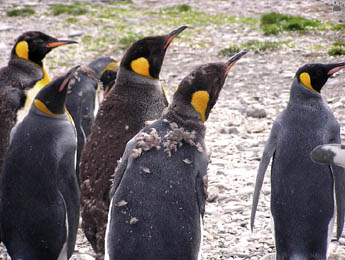
King penguin chicks molting into juvenile plumage. Grytviken,
South Georgia. |

Juveniles differ from adults (bird to the left) by paler yellow ear patches.
Grytviken. |

King penguins, Grytviken, South Georgia. |
King penguin is the largest breeding species of
the Scotia Sea. Its even larger relative, emperor penguin (A. forsteri),
breeds further south and visits the area during non-breeding season, but is very
rarely seen here. King penguins usually breed on flat snow-free beaches and adjacent
level areas. They are less migratory than some other species, but feed on fish
and squid 40-1,000 km from the colony. They can dive to almost 300 m and are fast
swimmers, but not as good at porpoising as some smaller penguins. |
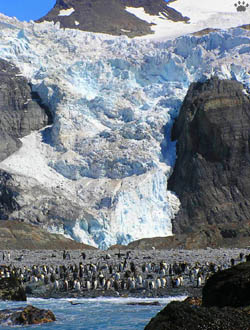
Small king penguin colony, Gold Harbour, South Georgia. |
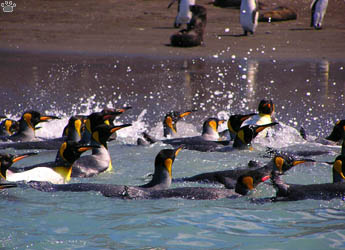
King penguins swimming. Gold Harbour, South Georgia. |
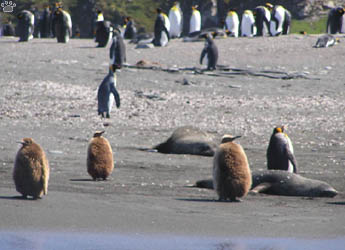
King penguin chicks sharing their beach with Antarctic fur seals.
Gold Harbor. |

King penguin, Grytviken, South Georgia. |
King penguins breed in colonies of up to 40,000
pairs on South Georgia (200,000 pairs in 32 colonies) and Falkland Islands (400
pairs), but are extinct on Tierra del Fuego. Another subspecies forms much larger
colonies in other parts of the Southern Ocean. They have extended breeding season,
with birds present at colonies at any time of the year. Chicks take 10-13 months
to fledge, so each pair only breeds twice every three years. Their population
is currently slowly rising. |
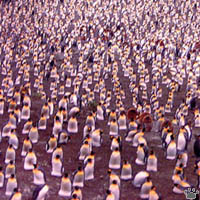
Part of king penguin colony, Gold Harbour. |
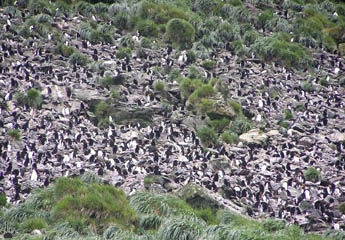
Macaroni penguin colony, Elsehul, South Georgia. |
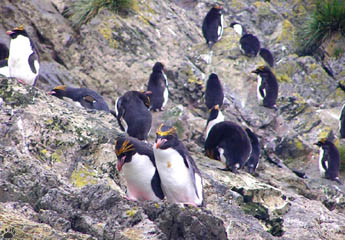
Macaroni penguins(Eudyptes chrysolophus), Elsehul, South
Georgia. |
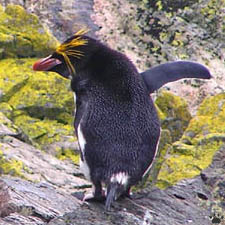
Macaroni penguin, Elsehul, South Georgia. |
Macaroni penguin prefers steep rocky slopes. About
half of the world's population breeds in Scotia Sea area, with 3 million pairs
in sixty colonies at South Georgia, and smaller colonies on all other island groups.
On the Falklands and Tierra del Fuego it is rare, but its close relative, small
rockhopper penguin (E. chrysocome), is very common (2.5 million pairs on
the Falklands, 175,000 on Tierra del Fuego). The latter is even better at rock
climbing and porpoising. |

Macaroni penguins, Elsehul, South Georgia. |
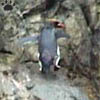 |
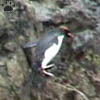 |
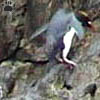 |
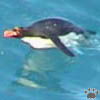 |
 |
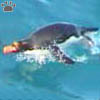 |
| Macaroni penguin rockhopping, Elsehul,
South Georgia. |
Macaroni penguin porpoising, off
Elephant I, South Shetland Islands. |
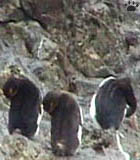
Macaroni penguin chicks,
Elsehul, South Georgia. |
Both macaroni and rockhopper penguins feed mostly
on krill, but partially switch to fish and squid when they feed their chicks,
or when krill populations crash. They usually dive to 10-80 m, and are are more
migratory than king penguins. Their breeding season is highly synchronized breeding
season, with all eggs in a colony laid within 2-3 weeks. Birds start arriving
to colonies in October, and leave in late February-March. Unlike king penguins,
they build nests of grass and pebbles and lay two eggs. The first egg is usually
smaller and seldom hatches. The numbers of both species are apparently stable
at the moment. |
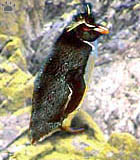
Rockhopper penguin,
Gypsy Cove, Falkland Islands. |

King penguins and Southern elephant seals (Mirounga leonina),
Grytviken.
Part 3: Penguins (continued)
Back to Part 1
Home
|